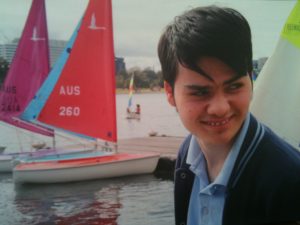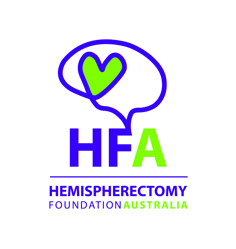
Hemi Hero: Gianni
Gianni was born in Melbourne on May 28, 1998, with impressively sized hands and feet. We
were told he’d be a six-footer, for sure. A full-term bub, he weighed 8lbs 8oz but at a very long
58cm, he looked like a 10-pounder who hadn’t filled out. As soon as he arrived, Gianni had a
right-sided seizure, but this was put down to the gruelling 32-hour labour.
In the next couple of weeks, we had a crash course in paediatric neurology, learned things we
never wanted to know. Our beautiful baby boy was born with medically intractable epilepsy
arising from cortical dysplasia.
Gianni had actually been seizuring in utero. I reported these occasional, rhythmic movements to
the midwives – they put them down to hiccups. In our first week at home he wasn’t feeding and
would emit little grunts and jerk forward. They too were seizures. I don’t blame the midwives or
doctors for not picking them up. Seizures in newborns can manifest in countless, subtle ways.
It wasn’t until we were back in hospital – to fatten up Gianni – that he had a full-blown, grand mal
convulsion. We moved wards – from the busy, bustling General to the deathly quiet ICU. When
the doctors first mentioned that Gianni was a candidate for this operation called a
hemispherectomy, I just about fainted. This was Frankenstein medicine. I thought: if this is the
solution – cutting out half the brain of a newborn – how bad must the problem be? How could I
hand over my precious, placid baby for such a disfiguring, life-altering operation?
Our neurologist explained that this wasn’t like a tumour, with surgeons fighting to take it out.
Gianni’s left brain was the tumour, although how much of it was malformed was hard to
determine. He was born with a full brain but some of the cells in his left hemisphere hadn’t
arranged themselves in the normal brick-wall pattern. They were in columns.
Although we had complete faith in our neurologist, Dr Simon Harvey, and all the medical team,
we wanted a second opinion. You don’t just hand over your newborn – and Gianni was healthy
and happy otherwise and making his early milestones – without being absolutely sure. This to
me felt like the last, worst resort, not the first. Maybe they would find a miracle drug that could
stop the seizures. We went through just about all of them.
Our stays at the Royal Children’s Hospital were becoming so frequent we called it the Hotel
California – though in retrospect; at the time there was precious little humour. Gianni underwent
countless EEGs (aka the Gianni special), MRIs, SPECT and PET scans. There were stretches
when he was seizure-free, but a fever was enough to restart the seizures and then all bets were
off. The old drug regimen would no longer be effective and a new cocktail would be trialled,
never knowing for sure if it would be successful.
Life revolved around Gianni’s medical appointments – scans, blood tests, neurologist,
paediatrician, physio, OT and speech therapy. No way to live. Still, I was terrified that
intervention would hurt Gianni and do greater, permanent damage. How could I justify that to
him? Once brain is removed, it’s not like you can replace it. Leaving him as he was born, at
least I could say nature made him that way. I remember the epilepsy foundation’s advice: get all
the information you can before making the decision. Whatever happens, you will know you did
the best you could with what you knew; you did everything for the best. But that was no comfort
to me at the time. Would I end up putting Gianni in a wheelchair, needlessly? Intervention was
loaded with risk.
We ended up getting a second, third and fourth opinion in the US, when Gianni was 10 months
old. To the eternal credit of our neurologist, Dr Simon Harvey, he encouraged us to seek all the
advice and opinion we needed to feel comfortable with our decision. Not all doctors can put ego
aside like that.
So in April 1999, we saw travelled to UCLA, Miami Children’s and Boston Children’s to help us
determine if Gianni needed surgery and how extensive it should be. The words of one doctor
echoed in my head for a long time: ‘Don’t let anybody tell you he needs a hemispherectomy.’
More than a year passed before Gianni finally underwent surgery on June 13, 2000. He’d just
turned two and had started walking at 23 months. Clearly, he was falling behind
developmentally and drugs were not completely effective against the seizures. Still, I had
nightmares for months leading up to the surgery. We decided on a more tailored operation than
a hemispherectomy, obviously to save as much ‘good brain’ as we could. Gianni had his left
parietal lobe removed and half the occipital, plus some of the temporal lobe and motor strip.
Unfortunately, this operation was not successful in removing all the bad brain and stopping the
seizures. Again it was explained to us like a tumour: leaving even a bit in there is still cancer, it
can still kill you. Gianni was back on his feet within a week, although with a more pronounced
hemiplegia. He’d lost some use of his right hand, had a visual deficit that saw him crash his
head into coffee tables and his behaviour was becoming more uncontrollable, more ‘autistic’ –
that is, more repetitive and ritualistic. His eating and sleeping were all over the place.
But we couldn’t face another surgery. Finally, the decision was taken out of our hands. At age 5,
after coming down with a cold in August 2003, Gianni started seizuring again and no cocktail of
drugs could stop it this time. He had zero quality of life, and would have starved to death from
the seizures. A hemispherectomy was the last resort now, the final throw of the dice.
Gianni underwent the all-day operation on 7 December 2003, when he was five-and-a-half. It
was a Sunday and the hospital had to open the operating suite just for him. I was so thankful
that his neurosurgeon, the incredible Wirginia Maixner, had the previous day off – her first in
about 26 days. Her record was five operations in one day. In the three years since his previous
surgery, the thinking had changed on hemispherectomies. Rather than physically remove the
brain, which could lead to swelling and pressure in the void, it was felt better to disconnect the
hemisphere from the rest of the brain, but leave it fitting in its own blood supply. So Gianni had a
hemispherotomy.
The Frankenstein operation that I had so dreaded was a miracle for Gianni. It gave him second
life. Although it was a scary time post-op because he had been so weak beforehand, he turned
the corner and came home just before Christmas. To my amazement, he started school on time
a month later. The physios and music therapists also worked miracles.
Gianni has been basically seizure-free ever since. Not completely – in the next year he was still
prone to febrile convulsions, so getting sick was always super stressful, but he grew out it. He
also relapsed in January 2008, just when we’d almost weaned him off all anticonvulsants. He
also has had a couple of insula seizures – from deep in the brain where it is impossible to
operate. These are fairly mild facial seizures, though the jaw-clenching is frightening.
But otherwise, as his dad says, Gianni is usually the happiest person in the room. He has issues
other than epilepsy. His intellectual disability is bigger than his physical, and he has strong
autistic features. He has never had functional speech. He knows a million songs and would
recite the weather and finance reports and entire picture-books word-for-word. Especially Hairy
Maclary and Dr Seuss. You could turn to any page of say, Horton Hatches the Egg, and he
would recite the text, based on the accompanying illustration. He listed all the continents and
oceans and knew the all the capital cities of South America – Caracas was the favourite – but
never told me he was hungry or hurt or had to go to the toilet. Of course, he didn’t know what a
capital city or continent or ocean actually is.
Since his mid-teens, Gianni has become almost non-verbal, preferring grunts, snorts and laughs
– how age appropriate. I miss his singing voice – music was always a language he understood.
He is not autistic in the sense that he is very social, uses eye contact to express his needs and
he intuits meaning from tone, emotion and gesture, rather than comprehension of language.
He’s always been placid and easy-going, and never hangs out alone in his room. He is
interactive but has no desire to communicate.
Gianni loves going out anywhere and being on the move – bus, tram, car, whatever. He loves
physical activity – walking, cycling, sailing, swimming – and has good ball skills – with basketball,
mini golf and totem tennis the faves. He learned to walk in order to kick a ball. He also loves
music videos and jigsaws on his iPad.
He loved his specialist school, St Paul’s College across the road from our house, and now
attends two day centres during the week. His new activities include lawn bowls, disco-dancing
and fishing from the pier at Frankston.
Gianni is living proof of a happy life after hemispherectomy. Hope in one hemisphere indeed!
